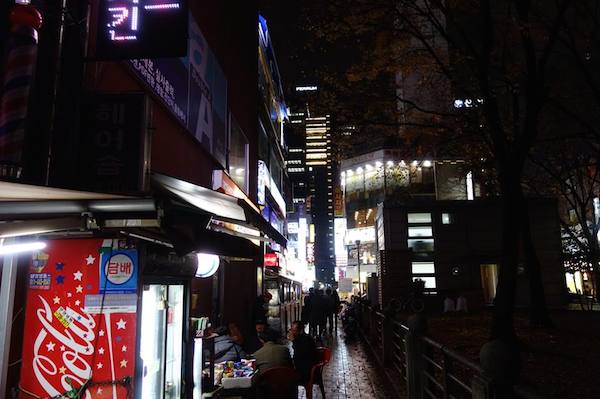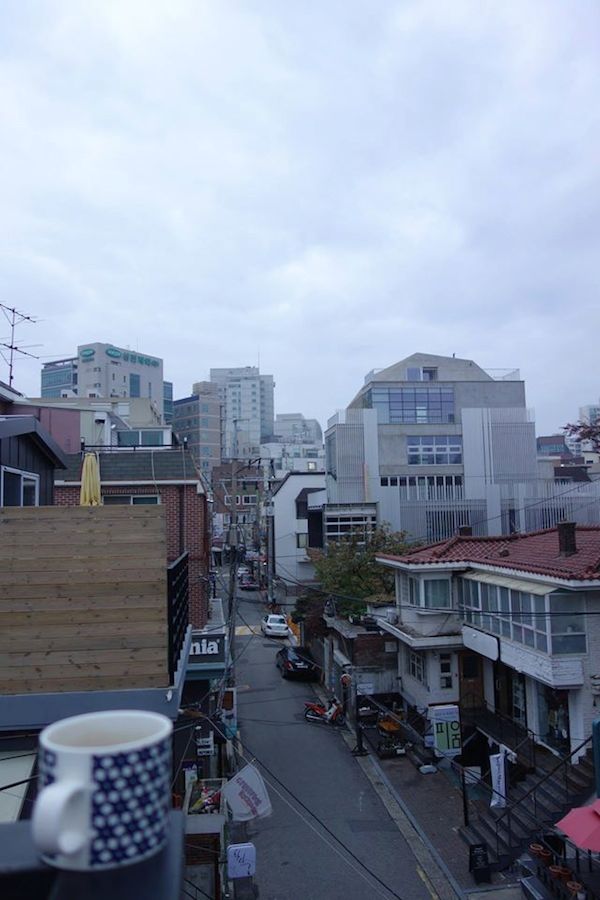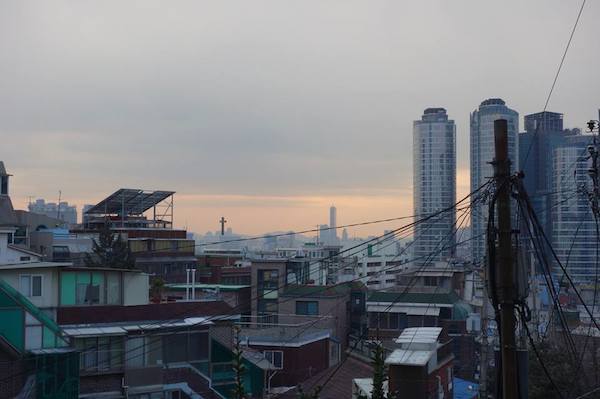Few books have changed the way I see cities Eastern or Western as much as Barrie Shelton’s Learning from the Japanese City. Were I an urban-planning academic, I’d want to write its counterpart for the Korean city myself. But until some urban-planning academic does take it upon themselves to write such a book, I actually recommend to those who arrive in and struggle to understand Seoul, or any less colossal Korean City, Shelton’s original. As I spend more time in Korea — punctuated by visits to its neighbor across the water, where I happen to sit writing this very post — the exercise of spotting the differences between it and Japan has become an exercise of spotting their ever-rarer similarities.
A great deal of work has gone into scrubbing away the imprint of the Japanese colonial rule, which lasted in Korea between 1910 and the end of the Second World War, including the demolition of structures built (no matter how well) during that time. Consequently, you don’t see much architectural similarity between, say, Seoul and Tokyo, but you do see a fair extent of overall urban similarity, beginning with the feelings both cities provoke in first-time Western visitors. “I was baffled, irritated and even intimidated by what I saw,” writes Shelton of his own early exposure to Japanese urban environments. “Yet at the same time, I found myself energized, animated and indeed inspired by them. The effect was liberating and my intuition was quick to suggest that further exploration of their chaotic vitality might be extremely rewarding.”
Tokyo and Seoul have long made this kind of unfavorable first impression, at least since, “to the ‘Enlightened’ Western eye of the latter half of the nineteenth century, the cities appeared drab, featureless and insubstantial,” and the observing Westerners, “almost without exception, could not see beyond the flimsiness of the individual buildings and the collective monotony of the cities.” Shelton even quotes the late nineteenth-century traveler Isabella Bird Bishop (about whose travels through Korea more in a later post) describing Tokyo as “‘a city of “magnificent distances” without magnificence’ meaning that it was an amorphous amalgam of grey featureless patches in a seemingly endless urban landscape.”
That description will sound familiar to every Seoulite, as will Shelton’s quotation of the Australian novelist Hal Porter on the Tokyo of the 1950s and 60s: “makeshift and confused, a freak weed sprung from a crack in history, and drenched by a fertilizer that makes it monstrous but not mighty, immense but immoral, overgrown and undercivilized,” despite the “unparalleled opportunities” for reconstruction, when “it was incinerated flat by the 1923 earthquake and the World War II bombings, to disentangle and straighten out its Gordian knot of streets.” And even now, “to most Western eyes, Japanese cities lack civic spaces, sidewalks, squares, parks, vistas, etc; in other words, they lack those physical components that have come to be viewed as hall marks of a civilized Western city.”
You often hear the same complaints in Seoul, and though the complainers sometimes do it from a well-informed place of genuine urbanist concern, they often sound to me like non-readers of the Korean or Japanese languages moaning about how the pages of a Korean or Japanese newspaper don’t make any sense. Maybe they just need to learn to “read” these cities, or so I came to believe after reading Shelton’s book, since he bases much of his examination of the Japanese city on the notion of the urban fabric as a text. Most intriguingly, to my mind, he compares at length the way of Japanese city-building with the way of Japanese writing, in which two different phonetic alphabets (one of them dedicated exclusively to foreign words) coexist with the pictographic kanji descended from Chinese characters and even the Western alphabet.
“All appear alongside each other or interspersed as a matter of course in the newspapers, on the streets, etc.,” Sheldon writes. In Japanese, “each character has an areal base and an invisible centre of gravity. Since each bears meaning and is, to some degree iconic, it has a good measure of independence.” In Western writing, however, “our letters are abstract symbols without meaning and depend upon precise linear spacing to achieve it. Further, they are complete within themselves (finite in number) and can only be readily understood if written in a horizontal left-to-right format.” Thus “the most fundamental difference between the two ‘ways of seeing’ in these fields appears to be that the Japanese is based on area while the Western is on line, and it is from here that other differences tend to flow: namely the relative independence and flexibility exhibited by the parts in the Japanese systems.”
As with the Japanese text, so with the Japanese city, where one-dimensional streets have far less importance as places or even as wayfinding tools than do units of two-dimensional area, where the buildings that occupy those areas and the activities that take place in them bear little obvious relationship to the context around them, and where vastly different aesthetic styles, eras of history, and layers of “meaning” appear all at once, parseable only with great difficulty, if at all, to uninitiated foreign eyes. (Not to mention all the actual text visible all around, the “vertical and roof signs joined by massive flat and animated ones, not to mention large- scale screens complete with sound — in effect, street cinema.”)
Shelton calls the layout of a Japanese magazine, and thus the layout of a Japanese city, “an intricate collage with no obvious centre and no clear edge,” words that remind me of any number of descriptions of Los Angeles, especially as it took its mid-twentieth-century form and struck so many observers as a brand new kind of metropolis. “When I imagine most Western cities, I think first of their streets and other spaces and the patterns of relationship between these: of major to minor streets, of monumental buildings to spaces, and of dominant centres to peripheral places. When I think of Japanese cities, I think of scattered points with no clear relationship between each other and often no clear form within themselves.”
And all throughout, “the Japanese city is quick to sever, discard, replace and re-form its parts according to the new needs of a rapidly changing world and without the Western concern for the wider visual context or pattern. Hence, the quality which so infuriates the Western observer seems also to be the Japanese city’s strength” — and the Korean city’s, and especially, with its famously short cycle of construction, demolition, and reconstruction, Seoul’s. Think of book whose text, already written in a variety of fonts, colors, and sizes (with pictures!), might change a word, a sentence, or a paragraph at a time even as you read it, but whose structure remains basically intact.
So it makes sense that Japanese and Korean cities would require their own navigational strategies. I’ve heard a fair few Western friends visiting Asia bemoan there countries’ lack of regular street grids, predictable street addresses, and even evident street names, but if they stay long enough, they start to internalize the necessary changes in perception. This comes especially quickly if they often ask for directions — which for these reasons they’ll need to do much more than they would in the West — and thus often get told to emerge from a certain subway station and walk toward the statue of the independence-movement freedom fighter, pass through a stretch of coffee shops, stop at the big bell and look for a couple of fried chicken places, then head up the winding path into the hill between them, and so on. The very terms used to give directions, especially in Korean, stresses context rather than path.
Hence, given “the haphazard nomenclature and numbering systems,” the importance of maps, a “common feature of regional and local newspapers, magazine and even billboard advertising” and an item commonly received along with an invitation to a private home. Shelton makes the point about Japan, of course, as did Roland Barthes when he wrote, in Empire of Signs, of how the Japanese “excel in these impromptu drawings” made to help recipients find their way through the cityscape. The Seoulite lives no less map-intensive an existence; several times a week, I come home to find a flier wedged in my door advertising my neighborhood’s newest yoga studio, hair salon, or Chinese food joint, its street address almost hidden away but a simplified (and usually self-aggrandizing, or at least self-exaggerating) map of its surroundings prominently placed.
But over and above these details of life lived in them, why does a Seoul or a Tokyo immediately feel so different to someone coming from New York, London, or Paris? Shelton points out another different in language that sheds light on the question: the lack of a sharp distinction between “urban” and “rural.” He cites the scholar of Japanese geography Paul Waley as “at pains to stress that the Japanese language has no equivalent words for ‘city’ and ‘country’ and there is no strong idea that sets the two kinds of places in some sort of binary opposition.” The Japanese language has the word inaka (田舎) and Korean the word chonseureopda (촌스럽다), both evocative of “rural isolation and ignorance, but this is hardly a positive or even romantic image of the rural scene, rather a negative product of space and time.”
Not quite so in the countries of the West, most of whom insist upon a comparatively stark urban-rural divide not just in language but in planning. Waley, “searching for some vaguely related notion” to the Western glorification of the countryside, “was able to note only the home place or furusato (故郷) as a notion holding some positive out-of-the-city association for urban Japanese — for most do continue to retain some link with and affection for their ‘home’ place. This is, however, more a personal point of reference of family or home surroundings (which may be much more than a village) than a general concept of countryside.” Koreans have the very similar concept of gohyang (고향), referring to whatever smaller hometown they left for Seoul — but probably without too many reservations.
The same goes for the difference, much labored-over in English, about the difference between “public” and “private” space. “Just as Waley suggests that there are no equivalent Japanese words which pit the idea of ‘city’ against that of ‘country,’” Shelton writes, referring to the novelist and Japan researcher John David Morley’s observation that, unlike in the West where “‘public’ is a powerful term,” indicating “all those places to which the entire community has both access and for which it has responsibility” while “private is possessed by an individual or group and is not generally open to the public,” the Japanese language has no equivalent distinction, even having to import public from English as the loanword paburikku (パブリック).
As the classes of private and public lack a clear distinction in the Japanese language, so they lack a clear distinction in the Japanese city: activities that might seem to the Westerner to belong to public spaces might easily happen in parts of the city that feel more like private ones, and vice versa. Seoul, a city often criticized for the few-and-far-between-ness of such classic Western-style public spaces as parks, works just the same way. Whether there, in Tokyo, or in any other city in these two countries, we’d do well read what goes on in the city as much as we read the places it goes on it. It goes along with what Shelton frames as the fundamental difference in Western and Eastern “thinking about space”: the former’s affinity with area which has it “put greater emphasis in city place-making on content (information, activity and animation),” and the latter’s with line, which makes it “more preoccupied by form (object, physical pattern and aesthetic composition).”
Shelton even assembles a list of all the organizational qualities that make Japanese cities the opposite of Western ones, from a preference for the patchwork over the network, decentralization over the centralization, temporariness over permanence, content over context, vague boundaries over clear ones, and fragments over wholes. No wonder Tokyo and Seoul seem illegible at first glance to someone who learned to read urban space in anywhere like a classical Western city, though I like to think that Angelenos — accustomed as they are to their city’s oft-criticized but unique interpretation of the decentralized, temporary, vaguely bounded and fragmentary patchwork — come with an advantage, however slight.
So many of Learning from the Japanese City‘s conclusions about its subject apply to Seoul as I experience it every day that I sometimes wonder if we even need a Learning from the Korean City. But the more thorough the similarities, the more glaring the differences, which brings us back to the analogy between the elements that make up a city and the language that makes up a text. Korea, needless to say, uses the Korean language, a different beast indeed than Japanese, and one without so much mixture of writing systems within. Korean texts, as well as Korean cityscapes, once incorporated a great many Chinese characters (and once, longer ago, had nothing but), though by now all but the most common have fallen into complete disuse. They also used the Japanese language, during the colonial period, but the process of de-Japanification has seen that it no longer makes up a substantial component of public life.
Pay a visit to a Seoul, then, and you’ll mostly see the distinctive — though linear, homogenous, and non-ideographic — Korean alphabet alongside, if not quite mixed with, ever more frequent splashes of English. What sort of a city does the thinking behind the Korean language, and the use of the Korean language as a visual texture, create? For the most part, we’ll have to wait and see. With every passing year, Seoul and the other cities of South Korea get a little farther from the decades of strong Japanese influence, and farther still from the centuries of strong Chinese influence before that. What sort of more fully Korean urban “text” will emerge down the line? Curiosity about the answer has, in part, brought me here myself. The text may undergo revision as you read the book, but the fascination of Seoul is that the language itself also gets invented.
You can follow Colin Marshall at his web site, on Twitter @colinmarshall, or on Facebook.






